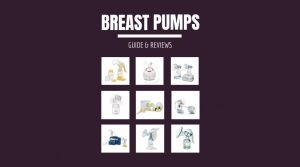The breast pump is an innovation which changed the face of motherhood for women, but achieving consistent, productive pumping sessions is still a goal which eludes many new mothers.
Understanding your body’s natural reflexes, the way your pump should fit, and how to operate the pump properly are all keys to success. A healthy, nutrient-rich diet and extra hydration are also essential, and forming a schedule and routine that you find personally calming and fulfilling can take a lot of the frustration out of the process (and potentially enhance your supply by helping you relax).
Ready to learn more?
Prioritize convenience over cost
When you’re expecting a baby, it’s logical to try and save your pennies, choosing mid-range quality pieces over luxury items that break the bank. However, buying a breast pump is a bad time to skimp.
A hands-free double breast pump, accompanied by a pumping bra, will offer you the maximum amount of functionality for your spend. Your pumping sessions will feel less tedious, and double pumps can easily be used as a single whenever necessary — essentially, you’ll be covered in all situations.
While a pump like this may set you back more than single pumps or those that aren’t hands-free, the comfort and convenience go a long way in creating a positive pumping experience.
Set realistic goals — don’t compare
If you’re thinking about a friend who was a prolific breastfeeder, boasting a freezer full of stored milk by the time her child hit toddlerhood — don’t.
Your body is your own, and everyone is different. Breastfeeding and milk production are a much smoother process for some women than others, and comparing your supply to a friend’s will only make you upset.
It’s also important to keep in mind that your milk supply increases over time to meet your child’s needs, and that a wide variety of factors can influence how much milk each woman is able to produce.
After you’ve fully established a pumping and nursing routine with your baby, it’s quite likely that your milk supply will become more consistent, especially if you incorporate pumping sessions about an hour after nursing. This allows your body time to replenish your milk supply, and signals your body that it should be producing more milk more frequently.
Create a calming routine for pumping
Creating a calming space to do paperwork, homework, or any other taxing task is a well-known strategy for achieving relaxation, and pumping should be no different. If you’re feeling tense, frustrated, or upset, your mental state can affect the success of your pumping attempt.1Mohd Shukri, N. H., Wells, J. C., & Fewtrell, M. (2018). The effectiveness of interventions using relaxation therapy to improve breastfeeding outcomes: A systematic review. Maternal child nutrition, 14(2), e12563.ncbi.gov
Choose a place in your home that is quiet and comfortable, and which has an ergonomically sound chair that allows you to lean forward while pumping. Prepare for your session by bringing in a glass of water and a healthy snack.
Listening to your favorite music or some relaxing nature sounds can help to calm your nerves. If you prefer watching television, listening to podcasts, or reading a book, these are also excellent ways to keep you calm and relaxed for optimum milk output.
Mind your food and water intake
Your body is working hard to make nourishment for your baby, but as is logical, this effort means you’ll need some extra calories and hydration to make up for the deficit. If you’re dehydrated or underfed, there’s a good chance you’ll struggle with your milk supply.
Increase your recommended caloric intake by 4-500 calories per day during breastfeeding, being sure to stick to healthy, nutrient-dense foods. You should also be drinking an additional 40 oz of water per day, for a total of 104 oz. 2Lactation
nap.edu
Stick to your schedule, but know when to be flexible
Using your breast pump will be most effective if you do it on schedule, rather than at random intervals. Once you have found a schedule that works for you, you may find that an increase in your milk production means you need to pump more frequently, or for a longer duration.
Many mothers find success scheduling pumping for about an hour after nursing. This signals the brain that more milk is needed on a more regular basis, boosting milk supply, and helps to fully empty the breasts after your baby’s nursing session.
Determine your best let down reflex triggers
Your let down reflex, which signals your body to release milk into your breasts for nursing, is generally triggered by the presence of your baby — their sounds, scent, warmth, and even the sight of them can be effective at letting milk down.
When you’re pumping at work or away from home, your let down reflex can sometimes be stubborn. Observe what your best let down reflex triggers are while you’re away from your baby; many mothers find that photos and videos of their baby are helpful, while others rely on breast massage, warm compress, and nipple stimulation to let down milk.
Invest in your comfort
If pumping is a painful process, it will be hard to convince yourself to keep on doing it. This begins with a good fit (see #8), but products like nursing pillows can help you get into a position that’s actually comfortable so that you can relax while you pump.
As we mentioned previously, hands-free double pumps with pumping bras are the optimal choice for comfort and ease during pumping. Using a rich, hypoallergenic nipple cream can also be helpful, as nipples can become sore, cracked, and chafed during the breastfeeding and pumping processes.
Know what a good fit looks and feels like
In order to extract milk from your breasts, pumps use a nipple shield with a tube attached, also called a flange, to create a secure fit. If a flange doesn’t fit against your breast and nipple correctly, your milk output may be poor, and worse, you may come away bruised and swollen.

Get to know your pump
Even though breast pumps perform the same basic function, each has different settings and functions. In order to get the most use out of your pump, take the time to carefully read through the instruction manuals and investigate the features.
Nearly all pumps have brief troubleshooting guides in their manuals, which can be helpful if you’re having trouble getting things started. It can also be helpful to read reviews and watch videos of other mothers who have used the pump to see it in action.
Incorporate massage and manual pumping
Fully draining your breasts after a breastfeeding or pumping session is an important part of avoiding painful clogged milk ducts, which can lead to mastitis. While electric pumps are wonderful for many things, they are not always capable of extracting the very end of a session’s milk supply.
Using a manual pump, which is an inexpensive investment, is often effective at fully draining your breasts. If you don’t have one on hand, using massage and hand-expression is also effective.
Rely on warmth
Many mothers find that warmth is a significant trigger of their let down reflex and a healthy milk flow. A warm shower or warm compresses can help to achieve this.
Likewise, using a blanket to stay warm and choosing a warm room of your house may be helpful in preventing issues related to temperature.
Don’t fight gravity
Just as we understand that flat on our backs is not always the ideal position for birthing, leaning back in a chair is not the ideal position for breastfeeding. Leaning forward to allow milk to flow downward through your ducts and be extracted can increase your output, and is especially helpful when trying to fully drain your breasts.
Choose a diet that may boost milk output
Though research is limited, there’s some scientific evidence that choosing certain nutrient-rich foods — referred to as galactagogues — may boost your milk output by increasing prolactin production.
Consider adding the following to your diet:
- Pumpkin 3Buntuchai, G., Pavadhgul, P., Kittipichai, W., & Satheannoppakao, W. (2017). Traditional galactagogue foods and their connection to human milk volume in Thai breastfeeding mothers. Journal of Human Lactation, 33 (3), 552-559.pubmed.gov
- Lemon Basil Buntuchai, G., Pavadhgul, P., Kittipichai, W., & Satheannoppakao, W. (2017). Traditional galactagogue foods and their connection to human milk volume in Thai breastfeeding mothers. Journal of Human Lactation, 33 (3), 552-559.pubmed.gov
- Thai Basil Buntuchai, G., Pavadhgul, P., Kittipichai, W., & Satheannoppakao, W. (2017). Traditional galactagogue foods and their connection to human milk volume in Thai breastfeeding mothers. Journal of Human Lactation, 33 (3), 552-559.pubmed.gov
- Fish Buntuchai, G., Pavadhgul, P., Kittipichai, W., & Satheannoppakao, W. (2017). Traditional galactagogue foods and their connection to human milk volume in Thai breastfeeding mothers. Journal of Human Lactation, 33 (3), 552-559.pubmed.gov
- Chicken Buntuchai, G., Pavadhgul, P., Kittipichai, W., & Satheannoppakao, W. (2017). Traditional galactagogue foods and their connection to human milk volume in Thai breastfeeding mothers. Journal of Human Lactation, 33 (3), 552-559.pubmed.gov
- Fenugreek Bazzano, A. N., Cenac, L., Brandt, A. J., Barnett, J., Thibeau, S., & Theall, K. P. (2017). Maternal experiences with and sources of information on galactagogues to support lactation: a cross-sectional study.International journal of women’s health, 9, 105.ncbi.gov
(Try to) get enough rest
This tip isn’t about milk supply, but it is about safety and self-care.
Breastfeeding and pumping routines can be very difficult, especially on a new mother who’s adjusting to sleep deprivation. Not only is this taxing to your mental state, but it’s disabling to the reflexes important to caring for your newborn baby — the CDC has established that sleep deprivation can be as disruptive to the body as alcohol consumption.4 Drowsy Driving
cdc.gov/sleep/about_sleep
Sleeping while your baby sleeps is not always as plausible as traditional wisdom suggests. If you can, rely on your partner, a parent or family member, or a trusted friend to care for your newborn in order to allow you to get some extra sleep.
Streamline your pump cleaning routine
Fully cleaning your pump out after each use throughout the day is as tedious as it sounds, but a clean pump is an important part of keeping your baby healthy.
One alternative is to place all of the parts of the pump which encounter milk into a Ziploc bag, and place them in your fridge until the next use. Then, at the end of the day, thoroughly clean the pump (invest in a cleaning kit, which makes this much easier).
Another option: a spare set or two of pump parts, which are usually available through the manufacturer’s website.
Our takeaways
Using a breast pump can offer a great deal of flexibility and convenience to a new mother, but understanding how your pump works, how it should fit, and when you should be pumping are key to achieving success. Creating a comforting routine that works for you, investing in gear like nursing pillows to help you stay comfortable, and taking care of your body through rest, proper hydration, and nutrition are some of the best ways to enhance the productivity of your pumping sessions.







